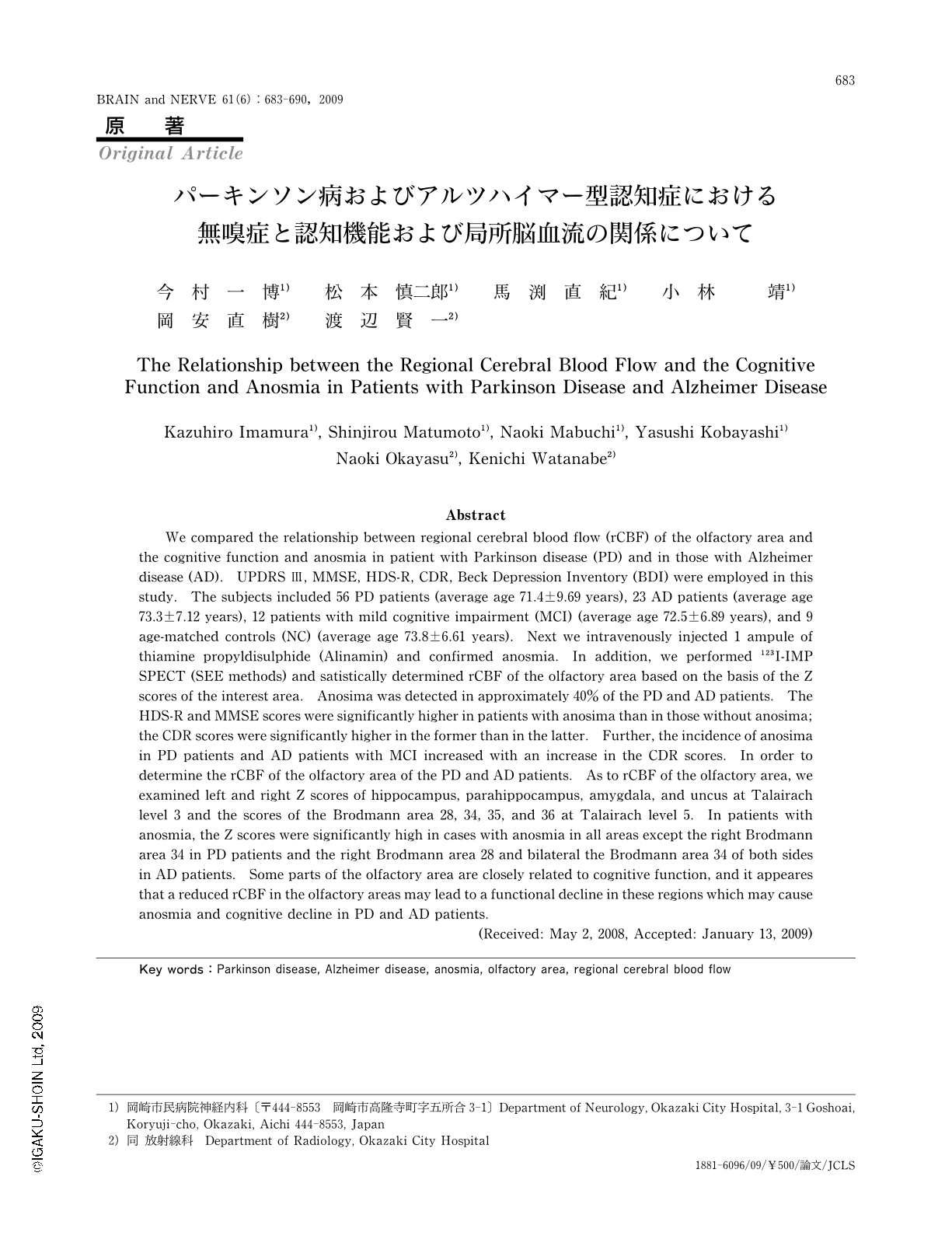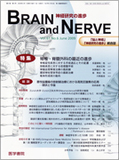Japanese
English
- 有料閲覧
- Abstract 文献概要
- 1ページ目 Look Inside
- 参考文献 Reference
はじめに
嗅覚障害はパーキンソン病(Parkinson disease: PD)において軽度のものを含めると7~8割の症例に認められる症候であり,その運動症状の発現前から認められる1,2)。またその嗅覚障害は,特定の症状の程度,全般的な重症度,罹病期間や治療内容,認知機能障害と関連しないことも報告されている3)。さらに病理学的にも嗅球,嗅索および嗅覚野にレビー小体が早期より出現することが報告されており4),このことがPDにおける嗅覚障害の原因になっていると考えられる。一方,び漫性Lewy小体病5)やアルツハイマー型認知症(Alzheimer disease: AD)6,7)の症例も早期から嗅覚障害を呈しており,それが認知障害の重症度と相関することが報告されている。しかし,これらの疾患の嗅覚障害と嗅覚野の局所脳血流との関連について検討した報告は見当たらない。
近年,個々の症例の脳血流画像を標準脳に変換して,正常データベースと比較することにより,異常部位をより客観的に表示する統計画像解析が行われるようになってきている8,9)。われわれは123I-IMP SPECTに3D-stereotactic surface projection(SSP)を用いることにより脳血流の三次元統計画像解析処理を行っているが,所見を定性画像として表示できる利点がある反面,特定の領域について解析する場合には該当部位の局所データを抽出することは技術的に困難であった。最近になり,三次元統計画像処理にstereotactic extraction estimation(SEE)法10)を併用することで,より客観的な評価が可能であることが報告されている。
既にわれわれはPDにおける嗅覚脱失(無嗅症)と認知機能障害に密接な関連があることを報告しているが,今回はPDにおける無嗅症と認知機能の関連についてADとの比較の上で検討し,さらに嗅覚野の局所脳血流との関連についても123I-IMP SPECT(SEE法)を用いて検討したので報告する。
Abstract
We compared the relationship between regional cerebral blood flow (rCBF) of the olfactory area and the cognitive function and anosmia in patient with Parkinson disease (PD) and in those with Alzheimer disease (AD). UPDRS Ⅲ, MMSE, HDS-R, CDR, Beck Depression Inventory (BDI) were employed in this study. The subjects included 56 PD patients (average age 71.4±9.69 years), 23 AD patients (average age 73.3±7.12 years), 12 patients with mild cognitive impairment (MCI) (average age 72.5±6.89 years), and 9 age-matched controls (NC) (average age 73.8±6.61 years). Next we intravenously injected 1 ampule of thiamine propyldisulphide (Alinamin) and confirmed anosmia. In addition, we performed 123I-IMP SPECT (SEE methods) and satistically determined rCBF of the olfactory area based on the basis of the Z scores of the interest area. Anosima was detected in approximately 40% of the PD and AD patients. The HDS-R and MMSE scores were significantly higher in patients with anosima than in those without anosima; the CDR scores were significantly higher in the former than in the latter. Further, the incidence of anosima in PD patients and AD patients with MCI increased with an increase in the CDR scores. In order to determine the rCBF of the olfactory area of the PD and AD patients. As to rCBF of the olfactory area, we examined left and right Z scores of hippocampus, parahippocampus, amygdala, and uncus at Talairach level 3 and the scores of the Brodmann area 28, 34, 35, and 36 at Talairach level 5. In patients with anosmia, the Z scores were significantly high in cases with anosmia in all areas except the right Brodmann area 34 in PD patients and the right Brodmann area 28 and bilateral the Brodmann area 34 of both sides in AD patients. Some parts of the olfactory area are closely related to cognitive function, and it appeares that a reduced rCBF in the olfactory areas may lead to a functional decline in these regions which may cause anosmia and cognitive decline in PD and AD patients.
(Received: May 2,2008,Accepted: January 13,2009)

Copyright © 2009, Igaku-Shoin Ltd. All rights reserved.


